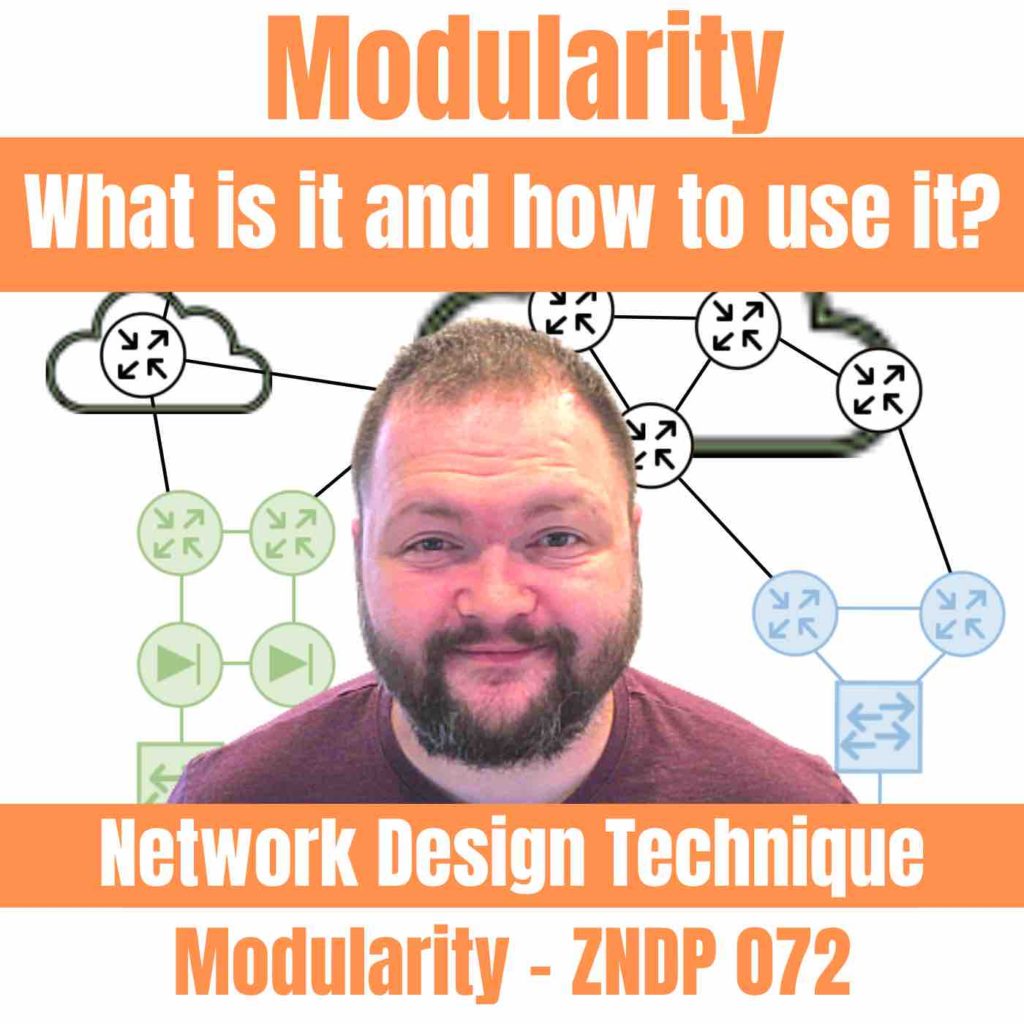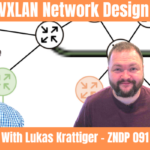
Here I talk about the Network Design Technique Modularity. Bad Network Designs Exist! I know its crazy but they do.
Shoot if they didn’t we wouldn’t have work as Network Designers!
This is a solo-show and it’s also our Christmas show!
Merry Christmas and Happy Holidays from the Zigbits family to yours!
Sometimes we all need a break and even on Christmas, you may need some personal time, so why not take a walk and plug in your Bluetooth earbuds, and have a listen to today’s episode. Also, this is our last show in 2020!
Here I talk about a Network Design Technique called Modularity. Bad Networks Designs do exist…shoot if they didn’t we wouldn’t have work as Network Designers. There are a number of Network Design Principles, Techniques, and Fundamentals that we all should know that will help mitigate Bad Network Designs from happening.
Check it out!
You’ll Learn
- Why you should care about modularity when it comes to your network design decisions.
- How you can leverage the concept of modular building blocks in your network designs.
- What Network Design Technique Modularity is.
- How to use Modularity to make your network designs more scalable, flexible, and manageable.
- How Purpose-built blocks can help you when you are designing a network.
- What different performance and scalability metrics should you leverage within your modularity design.
Resources
- Network Design Fundamentals
- Network Design Principles
- Other Network Design Techniques
- Demystifying The Roles
- My Network Design Course Weekly Status Emails
ZNDP 072: Network Design Technique Modularity
Zig Zsiga: Network Design Technique Modularity Episode 72.
Bad Networks Designs do exist. I know it’s crazy to think about but they do. I want to make sure you are prepared when you encounter one of these bad network designs. Today I am going to highlight modularity. What does this mean? This is about the Network Design Technique Modularity. How you can use it, why you should use it, what the benefits of it are, and how to ensure success every step of the way as you deal with these bad network designs. Enough of me yapping here, let's start the intro, here we go!
Zigbits Intro: Welcome back My Friends, Nerds, Geeks, and Ziglets out there. We have another episode of the Zigbits Network Design Podcast (ZNDP), where Zigabytes are faster than Gigabytes. We strive to provide real-world context around technology!
Zig: What's up, everybody? I hope everyone is doing great. Zig Zsiga here and welcome to episode 72 of the Zigbits Network Design Podcast. My Name is Zig Zsiga, I’m here to help you with Network Engineering, Network Design, and Network Architecture. And one topic that we have to cover is modularity! Modularity is a Network Design Technique that every Network Designer needs to be able to leverage appropriately!
Zig: Modularity is the concept of breaking design elements into functional blocks or pods. I personally like the concept of pods because it visually resonates with me. When I see a pod or a block on a diagram it makes sense to me that, that specific block is dedicated for a reason, whatever that reason is. I like to picture Legos as a child, building massive architectures one lego at a time.
Zig: Another part of the modularity concept is to help isolate technologies and corresponding capabilities within that block.
Zig: How do we put this into practice you ask? Well, let’s say we have a flat network with multiple campus locations. Let’s say we have a local K-12 school district, with 3 schools elementary, middle, and high-school connecting to a district office where the internet connection resides. Each of these schools is also connected together in a full mesh, to provide fast direct traffic between each school and the others. Let’s call this school district Gimars Central School District.
Zig: Now because of a recent pandemic, Gimars is forced to merge with another local K-12 school district called Banon Central School District. Banon also has 3 schools, an elementary, middle, and high school, along with a district office.
Zig: If we were to continue the process of doing a full mesh of locations, this would be one very larger, convoluted network, with an enormous amount of fiber running from school to school. Of course, this is an extreme example situation.
Zig: One Design option would be to leverage the Gimars District office, since it’s the internet edge block, as the central connectivity point for the entire merged school district. If we do this, we would now have 7 locations (3 Gimars schools, and 3 Banon Schools, plus Banon’s district office) connected to the Gimars district office.
Zig: With this design option, the Gimars District office “block” is performing two roles. The first role is the internet edge connectivity and the second role is that of a core block. If the combined school district now had to add 4 additional school locations to this network design, this would be a design problem.
Zig: To mitigate that situation, design option 2 would be a dedicated core block that all other sites would connect to, including the internet edge block from Gimars District office location.
Zig: From a scalability perspective, once the core block hit its scale limitation, then you would simply add a second core pod interconnected with the original core pod.
Zig: Within each pod/block construct, there would be its own layer 2 isolated boundary and associated Layer 3 mechanisms would be employed to limit the layer 3 failure impact between the other blocks.
Zig: In addition, each pod would have redundant devices and links, as a general rule for availability requirements.
Zig: If we compared the design we started with, with the design we have now, the network design technique modularity provides flexibility, scalability, and proper fault isolation that allows a network to function properly. We now can easily identify problems in the network, because we have associated fault boundaries within each POD we’ve designed. We can literally rule out non effected PODs in a matter of seconds to find the issue and resolve it.
Zig: With a modularity approach to network design, we can easily set performance factors and replicate each pod architecture as the network, and the business reaches these performance guidelines. If we need a new core pod or block, we add it. If we need a new internet edge block, we add it. If we need a new access block we add it. This is repeatable, expandable, and manageable!
Zig: Hey Friends, nerds, Geeks, and Ziglets that's going to close out today's episode of the Zigbits Network Design Podcast where we discussed the network Design Technique Modularity. Keep in mind that Modularity is one of our Network Design Techniques that we all should know. We'll have all the links and all the things mentioned on our show notes page.
Zig: I hope you and your family have a very Merry Christmas this year! We all need some joy in our lives here in 2020! Just think, one week left and it’s 2021!
Zig: I think a lot of us never learn Network Design elements until later in our careers, and my goal is to fix that. You can check out my other free podcast episodes and YouTube videos that do just that!.
Zig: If you haven't’ heard yet, I am creating a Network Design course! Yep I am doing this, its a real thing and I am super excited about it! This course is a vendor and certification agnostic Network Design Course. My goal is to literally make you the best Network Designer you can be no matter where you are in your career today, be it just starting out or a 30-year seasoned network engineer. If you want to hear weekly status updates on where we are with this course, join the email list here. I send out a quick email every Friday highlighting what I did that week and what I plan to do the next week. If you are interested in knowing more, sign-up here!
Zig: We also have a Zigbits community on Discord! Come hang out with me and the rest of the Ziglets out there as we have live discussions around Network Design. If you are interested here is the direct link to the Zigbits Discord Server.
Zig: If you have any questions, comments, or just want to say hi, You can find Zigbits on all of the socials: Twitter, LinkedIn, and Facebook by searching for Zigbits. You can also find me on twitter @Zig_Zsiga. You can also email me at Zig@Zigbits.tech.
Zig: Don’t forget to #AttackYourGoals #AttackTheDay #MakeProgress on the things you care about!
Zig: As always I appreciate and thank you for listening!
Zig: Bye for now!
Join The Zigbits Newsletter
Enter your name and email address and I'll send you periodic updates and advice that will help you in your career and life.
Come hangout with Zig and the rest of the Zigbits community in our Discord Server.
More Content for you to enjoy!

Do you need a CCIE to get the CCDE?
Do you need a CCIE, spending all of the time and resources in that process ...

Get Your License To Design with the CCDE – ZNDP 094
Show Notes Coming Soon. Show Notes Coming Soon. Come hangout with Zig and the rest of the ...

Global Scale Network Design with Malcolm Booden – ZNDP 092
Today we are talking about Network Design but at the Global Scale! What do you ...

How to Make VXLAN Network Designs Simple, Scalable, and Uncomplicated with Lukas Krattiger – ZNDP 091
This is a 100% technical show, we are diving into the weeds on VXLAN and ...

How Abstraction, Orchestration, and True Automation can make your Career Successful with Tim Fiola – ZNDP 090
How Abstraction, Orchestration, and True Automation can make your Career Successful! This is all about making ...

Network Design Principle Security – ZNDP 088
Network Design Principle Security! Network Design Principles… we have to know them and leverage them in ...

